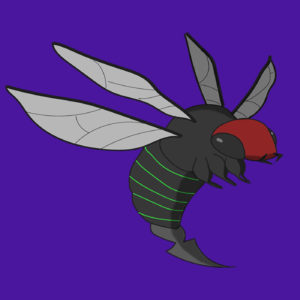Nifoloa (nif-oh-loh-ah)
Nifoloa flies were deadly insects with a short 24-hour lifespan. Its sting released a deadly dose of poison into the bloodstream of its victim. Blood red heads were a trademark warning for predators to stay far away from these venomous creatures. Once a nifoloa stung, it automatically died, so they would only attack if provoked. The green venom worked its way through a victim’s bloodstream until it reached the heart. Like bees, nifoloa flies died when they released their poison and would only sting when provoked. Veins glowed a bright sickly green as the poison worked its way to the heart, paralyzing the victim on the way. The only way to slow the poison was to cool the body down to slow the bloodstream. An abada horn was the only known way to stop it.
Mating was the nifoloa flies’ number one objective in life. Adults would typically mate with the first member of the opposite sex they see. Females laid up to 15 eggs in a carcass. The eggs hatched after two days of incubation. Nifoloa maggots were fat, ghostly white, nonvenomous larva that feasted upon the carcass they were born in as they matured into adulthood. Adults had an embarrassingly short one-day lifespan, during which they mated and flew to another dead animal to start the lifecycle all over again.

